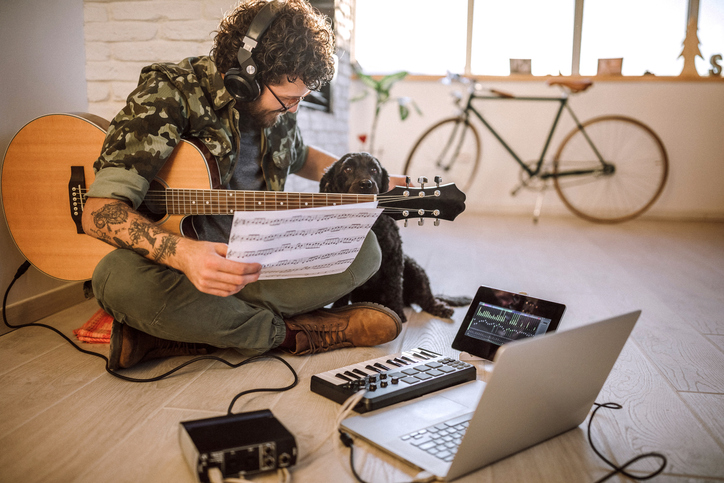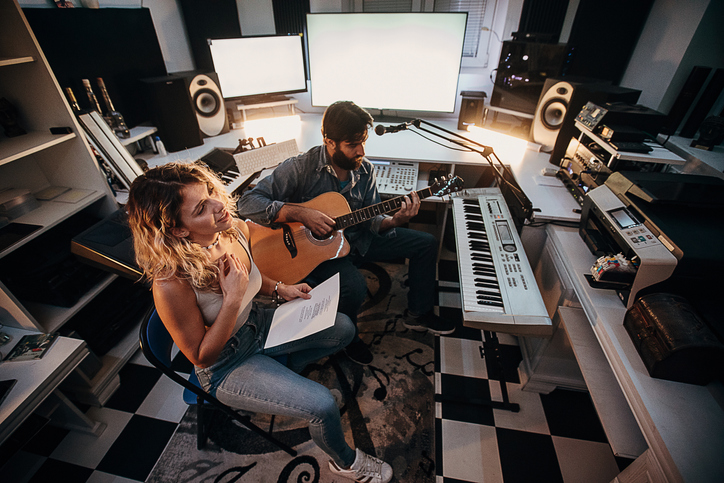Everyone loves a good pop song. Something about the tempo, the lyrics, and even the emotions speak to our souls. Pop songs remind us of our youth, our first love, and that one summer when all was right with the world. Pop provides us with nostalgic moments before we realize their significance.
Generations of people, young and old, have enjoyed the sounds of upbeat fun-loving pop songs. Whether it’s “Stayin’ Alive” by Saturday Night Fever or “Watermelon Sugar” by Harry Styles, there’s a reason pop music is always at the top of the charts.
So, what is it exactly that makes a pop song so incredible?
It all comes down to the anatomy of the song itself.
Table of Contents
Pop Music
Pop music was born in the mid-1950s in both the U.S. and the U.K. It’s short for “Popular Music” in the music industry, which pretty much explains itself.
It wasn’t until the late 60s that pop and rock music were defined as separate genres of music, thus the split that gives us the tunes we crave today.
The definition of pop music is music that is more commercial, accessible, and follows a specific formula when it comes to writing a good pop song that falls nicely in this genre.
So when you’re a songwriter writing a song, the pop song formula must include:
- Repeated chorus
- Hooks
- Repeated chords
- Short to medium song length
- Basic song format, usually verse-chorus structure
- Rhythms and tempos that are easy to dance to
The pop song formula also takes elements of other genres such as rock, dance, Latin, and country, and when it does, a song can fall into two (or more) genres too.
Regardless of how many genres you hit, it increases the likelihood that the song will be catchy and probably get stuck in your head.
Pop music song structure is memorable and often forges a connection between listener and song. It makes a point that sticks with us.
That’s just one of the many reasons people love pop songs, their catchy melodies and repeatable bars, but of course, there is also science behind the connection, regardless of things like the instruments used in the song (guitar, piano, keyboard, drum programming, and so on).

Why Do We Love Pop Songs?
We the listeners love pop songs because they can actually make us happy.
That’s right!
When we listen to pop (good pop, that is) our bodies actually release more dopamine which can positively affect our overall mood. Pop has also been shown to reduce stress, improve creative flow, and increase relaxation.
But wait, there’s more!
A study was done on 79 participants that looked at what pop does to the brain when you press play. They found that pop stimulated the regions of the brain responsible for handling emotions, learning, memory, and sound processing. The study also found that songs people found familiar with an element of surprise were songs that were determined to be most pleasurable.
Based upon these findings, we love a good pop hit because it’s familiar without being predictable.
Pop stimulates our memories, our emotions, and helps us retain information. On top of all that, it also increases dopamine and makes us feel good.
By breaking down pop music scientifically, it’s no wonder we all love it – pop creates a cacophony of good things internally that often cause external celebration (dance). All that comes through various clever combinations of a catchy melody, a first verse with a lyric that a listener relates to quickly somehow, smooth chord progressions, modern instrumentation, easy to follow notes, use of the common verse chorus bridge chorus chorus structures, and more.
It is this combination that makes us, the listeners, go back and hit play over and over again on what you, the artist and/or musician, want to write when writing pop music.
How to Write Pop Song: It Starts with Structure
Pop songs are responsible for saving humanity, so let’s get down to it and get your song going.
To begin to write a pop song, let’s take a look at the skeleton of a pop song. Pieces (or bones) like the verses, chorus, and hooks are all essential to writing a hit pop song.
The keyword in pop is catchy. This is the thing that gets a song stuck in your head.
While pop songs might not always include things like pre-chorus or a bridge, knowing all the options can help you decide what kind of structure your song needs and how you’re going to create it.
Every artist is different and that’s another element of songwriting that can make a hit (and could make people want to hit play repeatedly on your music).
Lean into what speaks to you most and what will convey the kind of emotion and ideas you want to be reflected in your song.
Don’t overthink it, and trust your gut: let the ideas, the lyrics, the melody, and the music flow out of you. Edit at the end, not at the beginning.
Verses
Verses are the story-telling element when you want to write a pop song. The chance to connect with your listeners and bring forth raw emotion lies within the verses. When it comes to pop songs, you might assume the verses need to be happy to match the overall tone of the song, but that isn’t necessarily the case.
Songs like “Hey Ya” by Outkast or “Pumped Up Kicks” by Foster the People definitely have fun vibes, but are actually about dark situations and ideas.
Are they great pop songs? Yes. Are they lyrically sad? Yes.
Don’t be afraid to inject your song with whatever emotions and idea you are feeling as it will make your song more authentic, and therefore more relatable to your listeners.

Use your verses to tell your story, no matter what that might be. You might even try splitting it into two or three parts as the chorus will be the same throughout. This is your chance to stretch your creativity as an artist and reel in your audience.
Pre-Chorus
The pre-chorus is optional in songwriting, but can serve as an impact booster to your chorus. For example, you could choose to use a chord progression from either the verses or the chorus to start your pre-chorus. This will create the familiarity that humans tend to latch onto.
You can also use the pre-chorus to create the element of surprise humans respond to in music. Changing the harmonies, the melody, or breaking the song pattern can make your song less boring and more intriguing.
Though both of these approaches are opposite, they both work to form an addictive quality in your overall structure.
It’s up to you which one is right for your particular sound and what you want people to hear when they hit play and listen.
Chorus
The chorus takes the overall emotions, thoughts, and creative ideas of your verses and expounds upon them. It acts as the synopsis of your song idea. You may have noticed most song titles appear in the chorus as well as the hook, the climax, and the part listeners will be singing for days.
The chorus is the strength of the whole song. It’s built up by the verse before it, the optional pre-chorus, and then the release of flowing beautiful words. The chorus is the originator and the verses are the echo. Everything leads up to the chorus.
This is the part of the song where you can deviate from story-telling and let raw emotion take hold. It is said that music is what feelings sound like. Let the emotion be the driving force behind your songwriting by letting the verses tell the story of the emotion and the chorus tell of the emotion itself.
Let yourself be vulnerable.
Hooks
There is some debate about hooks in the music industry. Some say the hook is the chorus. Some say the hook is a repeated phrase. Some say the hook can be instrumental, vocal, or both. It can be confusing, to say the least. But don’t get too hung up on this when you create and bring your idea to life.
When we look at song structure in pop culture they all seem to refer to the hook as the repeating line of the chorus that gets stuck in the listener’s head. In German, it’s referred to as “Ohrwurm,” which means “ear-worm”. It’s that thing — those words and lines to a certain rhythm — you can sing, even if you haven’t heard the song recently.
Basically, when we think of songs like “Single Ladies” by Beyonce, the line that comes to mind is, “All the single ladies, all the single ladies” because that’s her hook and what gives the song seemingly unending life (and most of us, if we’re being honest, could sing these lines forever…probably even with the correct rhythm, or close).
Hooks have been sought after since bards began serenading. When writing a hook, it’s best not to force it. When the perfect line that encompasses the power behind your song idea reveals itself, you’ll know.
Don’t overthink your hook and trust your instincts when you find it. As you the artist, musician, and/or singer continues the practice of creating songs — it is truly like exercise — you’ll learn to trust your inspiration and gut more and more as you join the ranks of professional songwriters.
It’ll eventually become second nature to you.
Bridge
The bridge is also an optional part of a song, especially in pop, but can serve as a transitional verse with a unique, but related, set of bars and/or chord progressions. It can give the audience that surprising change that keeps them entertained. It can also provide an opportunity for a key change. It can even signal the near ending of the song bringing it to an impasse.
Let it break up the monotony and lead the audience to the next part of the story. Keep it short and simple, but let the lyrics pack a punch. You can say a lot with a bridge and it can have a strong impact on the composition of your song and the presentation of your core idea.
However you choose to incorporate your bridge, it serves as a perfect place to change things up and allude to closer. The bridge takes place between the second or third chorus, whichever is last. The simple connection between beginning and end is a chance to ensure the whole story is tied up with a neat little bow.
Outro
The outro signals the listener that the song is ending. Most songs now end with a slow fade, which is far less jarring than an abrupt ending when it comes to song structure.
Sometimes the outro is a reverse of the intro, which might be upbeat. Sometimes the outro is reflected by slower singing and instruments. It all depends on how you want to ease your audience to the end of your song, and how you want to design the song structure.
When your track comes to an end, giving your listeners a sense of completion is imperative. While some rock songs are known for their abrupt jolting end and often big ending sounds, pop is a gentler genre. Easing the audience into the song and out of it are all part of the experience.
One thing is for sure, your unique approach to creating will start speaking to you once you begin the songwriting process — trust your gut.
When this starts happening, the perfect ending to your song will become clear. Whether it’s slowing down the track or fading into the distance, your outro will release listeners back into the real world, gently.

Common Formulas
Common pop song formulas are simple with one or two deviations from the regular flow. Typically artists choose two or three different verses with one chorus that is repeated between each verse.
Other variations include:
- Verse
- Pre-chorus
- Chorus
- Verse
- Pre-chorus
- Chorus
Or
- Verse
- Chorus
- Verse
- Bridge
- Chorus
Or even
- Verse
- Pre-chorus
- Chorus
- Verse
- Bridge
- Pre-chorus
- Chorus
- Outro
There are many combinations to choose from when it comes to writing a pop song. Some are complex and some are simple.
Although, determining which song order is best doesn’t always come down to the formula. Every song is as unique as the writer and shouldn’t be constrained to what works for other artists. What works for one songwriter might not work for another and that’s totally normal.
Four Chord Songs
If you’re a lyricist and not a musician, you can skip this part, but be aware that it’s incredibly interesting. As music is a huge part of songs in general, it’s good to know what kind of music is most loved historically. Enter, four-chord songs.
Now, you can’t talk about pop songs without addressing four-chord songs. If you’re going to write a pop song, some of the most successful songs have the same four chords in the key of E. the magic four chords are E, B, C# Minor, and A.
These four chords have been used to create some of the most memorable songs in history such as “Don’t Stop Believin'” by Journey, “Forever Young” by Alphaville, and “I’m Yours” by Jason Mraz. While these songs aren’t exclusively made up of these four chords in the same chord progression, they are utilized within each one.
While there’s no way to predict how a song will affect people, there is definitely a bit of something special about E, B, C Minor, and A together as a chord progression. Putting your own spin on these four chords might just open the gates to pop song paradise.
For example, especially if you’re stuck, try to play with this chord progression on your own and see for yourself how it feels, giving it your own spin when it comes to rhythm on whatever instrument you’re most comfortable on (piano, guitar, or something more exotic…that’s up to you).
It could be right for your song’s concept or it might be totally wrong, either way, you’ll never know until you try and start writing.

Get Started
So, now you have all the tools for writing a perfect pop song. You can bring your song to life using whichever structure you choose, utilize information on what makes a catchy song, and even try out the four-chord formula as you play around.
With all the different combinations possible, your new song and the lyrics everyone might soon be signing is sure to be a work of art that fully encompasses your hopes, your dreams, and the things you are passionate about…something you are proud of and want others to hear.
Now that you have got an arsenal of tips and approaches to use when inspiration strikes — and as you improve in your songwriting ability, even when it doesn’t — it’s time to get started! (You won’t know what could come out until you do!)
Get your laptop or your notebook, pony up to a guitar or piano or start with a beat and a few notes, and let those lyrics flow. Freely hit record on Logic X or Garage Band and sing some melody ideas into a mic (even if its cheap or a crappy one). There is no limit to the amount of brainstorming you can do or verses you can create when you’re writing and getting into a good creative mindspace.
Get it all out, just create, and then when you’re done writing you can organize your thoughts, feelings, words, lyrics, notes, and lines into a beautiful song with an unforgettable melody.
The best thing about writing a pop song is that it’s yours.
Allow yourself to own every part of your new song. From verses to chorus to the outro, from words to lyrics to the rhythm itself, let it reflect who you are and be proud of what you’ve accomplished after hitting record.
We can say here, from first-hand experience, that there is no better feeling than seeing people react positively to a song you wrote when they hear it for the first (or hundredth) time.
Once you have completed your new musical endeavor, don’t forget to see our article on How to Copyright a Song for tips and a step-by-step how-to on protecting your lyrics, melodies, notes, song structure, chord progressions and all that went into the production of your next hit record!
The entire team here at HUDL Music is excited to hear the next hit track you write, maybe, just maybe, on the radio soon!

